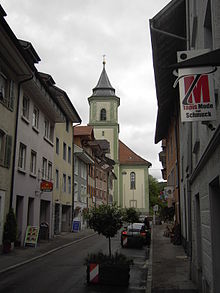Liebfrauen (Waldshut)
The Catholic parish church Liebfrauen is the city parish church in Waldshut in the district of Waldshut . It is dedicated to Our Lady and John the Baptist . The patronage is August 15th.
history
Previous construction
Under the rule of the Counts of Habsburg , the construction of the town of Waldshut began around 1250 on the western spur along the Seltenbach. First the St. Johanneskirche was built , around 1300 a branch of the parish church St. Clemens in Dogern and owned by the Counts of Homberg and Habsburg. John the Baptist and Catherine of Alexandria became the city's patron saints. In 1335 Queen Agnes of Hungary bought the farms in Dogern and the church set in St. Johann for the Königsfelden monastery .
During the reign of the Roman-German King Rudolf I , the further expansion of the town took place under the direction of his son Landgrave Albrecht, who was declared of age . A second church for Oberwaldshut was dedicated to the Habsburg saint, Leodegar von Autun . The monastery of St. Gallen handed over the farm in Tiefenhäusern, to which the church in Stunzingen and the daughter church in Waldshut, St. Leodegar, belonged, to the Counts of Habsburg as a fief.
In 1360, Count Johann von Habsburg also acquired the fiefdom of St. Leodegar as his own property in order to transfer it to Queen Agnes. According to another source (Lichnowsky IV, Reg. 1321), the Königsfelden Monastery was awarded the Church of St. Leodegar by the Dukes Leopold and Albrecht in 1377 as a replacement for the devastation caused by the Gugler invasion . The Königsfelden monastery thus became the sole lord of the church in Waldshut until the Reformation.
With the Fuchsian Treaty of March 14, 1526, St. Johann lost the parish rights to the Upper Church of St. Liebfrauen and was “only” a minor church. In the early 15th century, the Church of St. Leodegar changed its patronage in honor of Our Lady. During the Waldshut War , the church, which was originally located next to the Upper Gate, was so badly damaged that it was rebuilt with the inclusion of the city wall and the northeastern defense tower. Even under Balthasar Hubmaier, who caused the iconoclasm with the introduction of rebaptism , the church suffered great damage; no works of art from the pre-Reformation period have survived. In 1528 the Königsfelden monastery was dissolved, and the rights went to the city of Bern . In 1683 St. Blasien acquired the rights for 18,500 guilders from Bern.
Partial demolition and new construction
The new building of the church, still in the style of early classicism in the succession of Ixnard , took place after the previous building was demolished. The surrounding walls of the choir have been preserved. In the previous centuries, the Church of Our Lady, also known as the “Upper Church”, had suffered various damage from acts of war. In 1784 it was found to be in disrepair and it was decided to demolish it. The St. Blasian master builder Sebastian Fritschi from Hüfingen took on the accord ; the building became his main work despite the mishaps. The foundation stone was laid on October 8, 1805. On February 28, 1805, parts of the choir and the tower, which was overloaded with embedded bricks and built in 1468 on the weak foundation of the defense tower, collapsed. The bells rang partially in the Seltenbach Gorge. Then the tower opposite was rebuilt. Johann Friedrich Vollmar was responsible for the interior design . On August 15, 1808 the church was designated by Pastor Josef Bidermann. Between 1804 and 1808 the lay church of the Capuchin monastery was used as an interim.
In the meantime, the Abbey of St. Blasien , which had patronage over the church and was therefore obliged to build it, had been abolished. The grand-ducal government, which was careful about ecclesiastical affairs, ordered the reuse of parts of the interior of the St. Blasien Cathedral. However, a considerable part of the alabaster equipment did not survive the transport. Material from the old church was also reused.
The organ of the previous building was created by Christoph Albrecht . In 1814 Michael Gassner from Koblenz made a new organ with 28 registers . The bells are among the oldest in the Archdiocese of Freiburg, some of them still come from the previous building.
The second parish church in Waldshut St. Johann, also called Lower Church , was intended for demolition in 1784 and also demolished in 1804.
literature
- Josef Isele, Hans Jakob Wörner: Catholic parish church Liebfrauen Waldshut / Hochrhein. 1978, Schnell u. Steiner Art Guide No. 1101
Web links
- History and description on the website of the pastoral care unit Mittlerer Hochrhein St. Verena
Coordinates: 47 ° 37 '23.3 " N , 8 ° 12' 53.6" E

